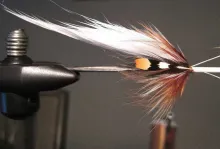A very successful Danish muddler tube fly developed by Kim Sorensen for salmon and sea trout, particularly suited for slow water.
Danish fly angler and fly-tyer Kim Sorensen is "a Guideline man" as he says, meaning that he is on Swedish Guideline's team of anglers and fly-tyers - what Guideline refers to as their Power Team. You can also find Kim on Facebook.
In that role
Kim was fishing in the Swedish river Mörrum in 2011, and "no one was really catching anything" as he says.
At one point on of their Swedish hosts, Allan Bloch of the flyshop Fiskeshopen in Mörrum said:
"Now is it!"
He took them down to Mörrum's Pool 15 and showed the Danes how to fish in a way they hadn't fished before. The flies used were large and bushy, and according to traditional Danish thinking large and bushy flies for salmon and sea trout are fished in the surface.
Not so the flies that Allan used.
Large and bushy maybe, but weighted and fishing deep. They were different large volume hair winged flies tied on long tubes with trailing hooks, and they produced!
Salmon were caught after several skunked days.
Tying steps
This experience left
an impression with Kim, and during the tying season 2012 he and his fishing buddy Frank Thornild decided to create a sinking, bushy fly for their home water, the Danish Storaaen (literally The Large Stream), which runs in their backyard as >Kim puts it.
Storaaen is a fairly slow flowing river compared to the sometimes frothy and wild Mörrum and in Kim's and Frank's eyes that called for a fly, which was a bit different from the ones originated by Swedes such as Ulf Sill and others.
Kim and Frank opted for a shorter tube, weighted it with beads and tied the wing using a soft zonker strip rather than loose Arctic fox hairs as used in many salmon flies. The Zonker strip is generally much more mobile than the stiffer hair, and zonker flies work very well in slow water. To some flies they added some rubber legs just to give the fly even more life, while others got some flash for more visibility.
All flies were finished with a couple of Jungle Cock eyes and a wide and bushy muddler head, trimmed fairly flat in the front. The result wasn't as much a specific pattern as it was a basic principle for a fly that would show itself to work really well.
During the season of 2012 the yet unnamed fly was fished by Kim and Frank.
And it worked.
On one fantastic day
it produced 7 salmon between the two of them. Now to set things in perspective, 7 salmon during a whole season would have most Danish salmon anglers running on the ceiling the whole following winter, so catching this number in a day is any Danish salmon angler's dream.
So the fly earned it's wings and was baptized The Munker by Frank. As he said: "Muddler and Zonker. What can that become other than Munker?"
Muddler and Zonker.
What can that become other than Munker?
And since its premiere
season the Munker has become a very popular fly and has seen the light of day in all kinds of disguises combining different colors, with and without Jungle Cock, flash and rubber legs. Tied on various tubes, adding weight, but still maintaining the typical profile: compact, heavy and pretty chubby, moving a lot of water in the murky depths of the often slow Danish salmon streams.
Kim ties a handful
of different variations, but basically uses the Guideline FITS plastic tubes and one or two beads - aluminum, brass or tungsten depending on desired weight. The bead(s) get slipped on the tube and glued to the rear after a small collar has been melted and the tube is then mounted on a tube needle as and the tying can commence.
Kim prefers to use materials from Danish Futurefly who has a large selection of quality hair and skins in particular.
A video by Kim Sorensen showing the Munker in action on the slow flowing Storaaen in Denmark, a river that calls for mobile flies and where the Munker has done very well.
- Log in to post comments
































Yes. I am using sink
Yes. I am using sinking line when fishing with that type of flies......... Kim
Great articel, and b
Great articel, and beautiful flies... Niels Have
Looks great ! Is thi
Looks great ! Is this fly fished on a sinking line ?
What a fantastic pat
What a fantastic pattern.......... beautiful!